Contents
- Extension of Pradhan Mantri Vaya Vandana Yojana (PMVVY)
- Pradhan Mantri Matsya Sampada Yojana
- Amphan Landfall process has commenced
- 100 % solarisation of Konark sun temple
- Agappe Chitra Magna for detection of COVID 19
- Inland Water Transit and Trade between India and Bangladesh
EXTENSION OF PRADHAN MANTRI VAYA VANDANA YOJANA (PMVVY)
Focus: GS-II Social Justice
Why in news?
The Union Cabinet has given its approval to the Extension of Pradhan Mantri Vaya Vandana Yojana (PMVVY) and other changes for the welfare of and to enable old age income security for Senior Citizens.
Changes for the Welfare of the aged
- Extension of Pradhan Mantri Vaya Vandana Yojana (PMVVY) up to 31st March, 2023.
- Revised rate of returns of Senior Citizens Saving Scheme (SCSS).
- Approval for expenditure to be incurred on account of the difference between the market rate of return generated by LIC.
- The minimum investment has also been revised to Rs.1,56,658 for pension of Rs.12,000/- per annum and Rs.1,62,162/- for getting a minimum pension amount of Rs.1000/- per month under the scheme.
Pradhan Mantri Vaya Vandana Yojana (PMVVY)
- Pradhan Mantri Vaya Vandana Yojana (PMVVY) is a Pension Scheme announced by the Government of India exclusively for the senior citizens aged 60 years and above.
- PMVVY is a social security scheme for senior citizens intended to give an assured minimum pension to them based on an assured return on the purchase price / subscription amount.
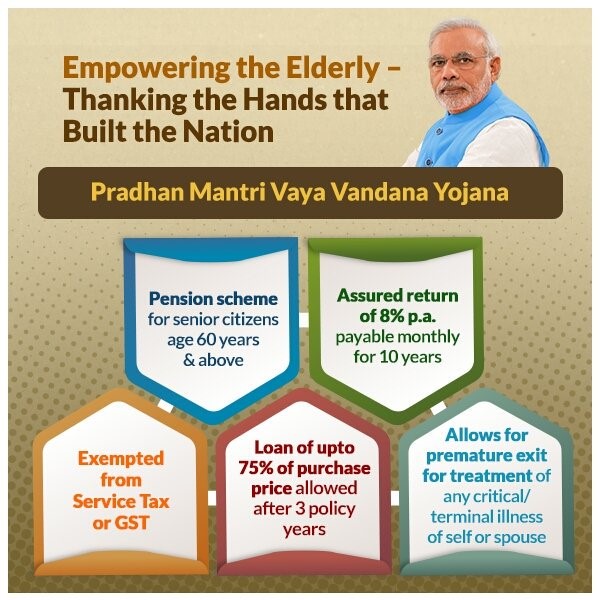
Major Benefits of PMVVY
- Scheme provides initially an assured rate of return of 7.40 % per annum for the year 2020-21 per annum and thereafter to be reset every year.
- Annual reset of assured rate of interest with effect from April 1st of financial year in line with revised rate of returns of Senior Citizens Saving Scheme (SCSS) upto a ceiling of 7.75% with fresh appraisal of the scheme on breach of this threshold at any point.
- Pension is payable at the end of each period, during the policy term of 10 years, as per the frequency of monthly/ quarterly/ half-yearly/ yearly as chosen by the pensioner at the time of purchase.
- The scheme is exempted from GST.
- On survival of the pensioner to the end of the policy term of 10 years, Purchase price along with final pension installment shall be payable.
- The shortfall owing to the difference between the interest guaranteed and the actual interest earned and the expenses relating to administration shall be subsidized by the Government of India and reimbursed to the Corporation.
PRADHAN MANTRI MATSYA SAMPADA YOJANA
Focus: GS-II Social Justice
Why in news?
The Union Cabinet has given its approval for implementation of the Pradhan Mantri Matsya Sampada Yojana (PMMSY).
Pradhan Mantri Matsya Sampada Yojana (PMMSY)
- PMMSY is a scheme to bring about Blue Revolution through sustainable and responsible development of fisheries sector in India under two components namely, Central Sector Scheme (CS) and Centrally Sponsored Scheme (CSS).
- The Scheme will be implemented during a period of 5 years from FY 2020-21 to FY 2024-25 established under the Department of Fisheries
- Nodal Ministry: Ministry of Fisheries, Animal Husbandry and Dairying. – The new ministry was formed on May 2019 in order to promote the allied farm sector that has huge potential to help achieve the government’s target of doubling farmers’ income by 2022.
Major Benefits of PMMSY
- Address the critical gaps in the fisheries sector and realize its potential.
- Augmenting fish production and productivity at a sustained average annual growth rate.
- Improving availability of certified quality fish seed and feed, traceability in fish and including effective aquatic health management.
- Creation of critical infrastructure including modernisation and strengthening of value chain.
- Creation of direct gainful employment opportunities to about 15 lakh fishers, fish farmers, fish workers, fish vendors and other rural/urban populations in fishing and allied activities.
- Boost to investments in fisheries sector and increase of competitiveness of fish and fisheries products.
- Social, physical and economic security for fishers and fish workers.
Details of Implementation
- Central Sector Scheme (CS) – The entire project/unit cost will be borne by the Central government (i.e. 100% central funding).
- The Centrally Sponsored Scheme (CSS) Component is further segregated into Non-beneficiary oriented and Beneficiary orientated subcomponents/activities under the following three broad heads: Enhancement of Production and Productivity, Infrastructure and Post-Harvest Management and Fisheries Management and Regulatory Framework.
- For the Centrally Sponsored Scheme (CSS): cost will be shared between Centre and State.
AMPHAN LANDFALL PROCESS HAS COMMENCED
Focus: GS-I Geography, Prelims
Why in news?
- The National Weather Forecasting Centre/Cyclone Warning Divisionof the India Meteorological Department said – The Landfall process has commenced for the Super Cyclonic Storm ‘AMPHAN’ (pronounced as UM-PUN) and the forward sector of the wall cloud region is entering into land in West Bengal.
- After landfall, the system is likely to move north-eastwards close to Kolkata.
Structure of a Cyclone
A cyclone’s center, known in a mature tropical cyclone as the eye, is the area of lowest atmospheric pressure in the region.
Near the center, the pressure gradient force and the force from the Coriolis effect must be in an approximate balance, or the cyclone would collapse on itself as a result of the difference in pressure.
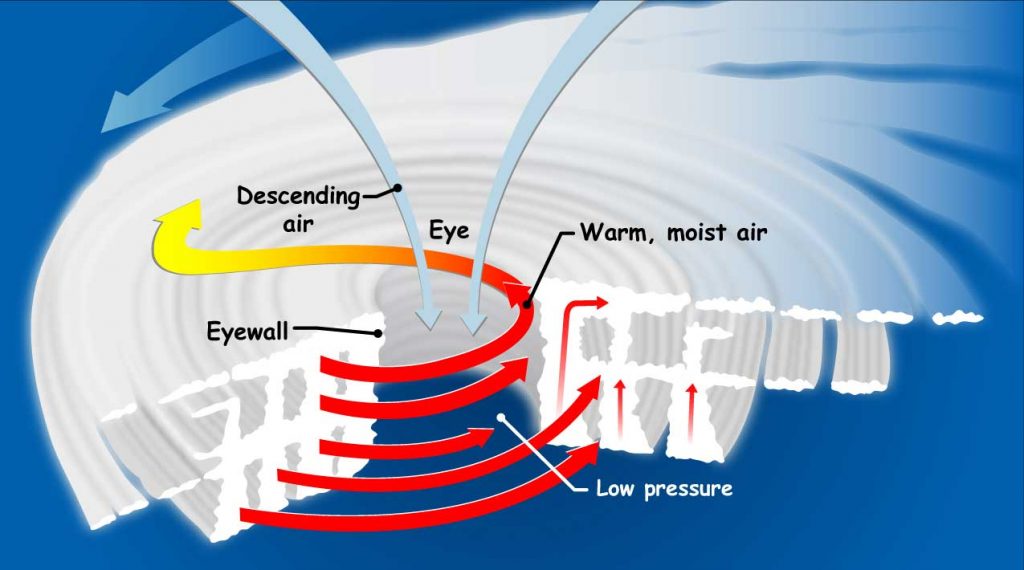
The eye
The eye of the storm is the centre. It’s a relatively calm space. When the eye passes over an area, winds slow down and everything feels like it has cleared up. But this is the proverbial calm before the storm, as the part that comes after the eye usually inflicts the most damage.
The eyewall
This is where the most effective part of a cyclone rests. The eyewall houses extremely high wind speeds, causing damage to both lives and property. It is a ring of thunderstorms, and changes in the eye or the eyewall affects the storm’s intensity.
Rainbands
These are the outer parts of a cyclone where sudden bursts of rain happen. There can also be gaps betwen rainbands where no rain or wind occurs.
Landfall, What happens when a Cyclone reaches land from the ocean?
- Tropical cyclones dissipate when they can no longer extract sufficient energy from warm ocean water.
- A storm that moves over land will abruptly lose its fuel source and quickly lose intensity.
- A tropical cyclone can contribute to its own demise by stirring up deeper, cooler ocean waters. tropical cyclone can contribute to its own demise by stirring up deeper, cooler ocean waters.
Click Here to read more about the Formation of a Tropical Cyclone
100 % SOLARISATION OF KONARK SUN TEMPLE
Focus: GS-I Art and Culture, Prelims
Why in news?
The Ministry of New and Renewable Energy (MNRE) has taken up the Complete Solarisation of Konark sun temple and Konark town in Odisha.
Details
- Government of India launched the Scheme with an objective to develop the historical Sun temple town of Konark in Odisha as ‘Surya Nagri’, to convey a message of synergy between the modern use of solar energy and the ancient Sun Temple and the importance of promoting solar energy.
- The Scheme envisages setting up of 10 MW grid connected solar project and various solar off-grid applications like solar trees, solar drinking water kiosks, off-grid solar power plants with battery storage etc.
- The Project will be taken up with a 100% Central Financial Assistance (CFA) support of around Rs. 25 Crores from Government of India through Ministry of New & Renewable Energy (MNRE).
- Implementation of this Project will be done by Odisha Renewable Energy Development Agency (OREDA).
- The Scheme will meet all the energy requirements of Konark town with solar energy.
Konark Sun Temple
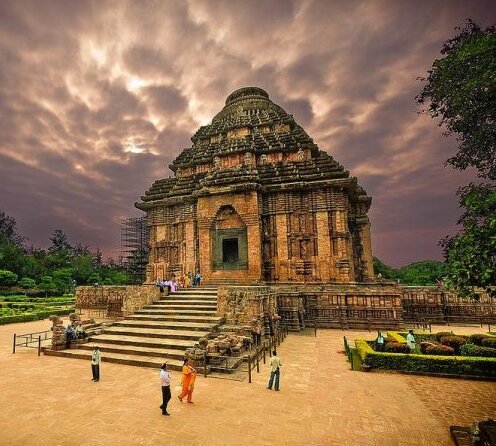
- Konark Sun Temple (Surya Mandira) is a 13th-century CE Sun temple at Konark northeast from Puri on the coastline of Odisha, India, and was declared a UNESCO World Heritage Site in 1984.
- The temple is said to be built in the13th century by King Narasimhadeva I (AD 1238-1264) of the eastern Ganga Dynasty.
- The Konark Sun Temple was built from stone in the form of a giant ornamented chariot dedicated to the Sun god, Surya.
- It marks the highest point of achievement of Kalinga architecture, known for architectural grandeur and intricacy of sculptural work.
- It has 24 elaborately carved stone wheels which are nearly 12 feet in diameter and are pulled by a set of seven horses.
- It is one among the three famous stone chariots in India-
- Konark Sun Temple, Odissa,
- Mahabalipuram, Tamil Nadu, and
- Hampi Chariot, Karnataka.
- When viewed from inland during the dawn and sunrise, the chariot-shaped temple appears to emerge from the depths of the blue sea carrying the sun.
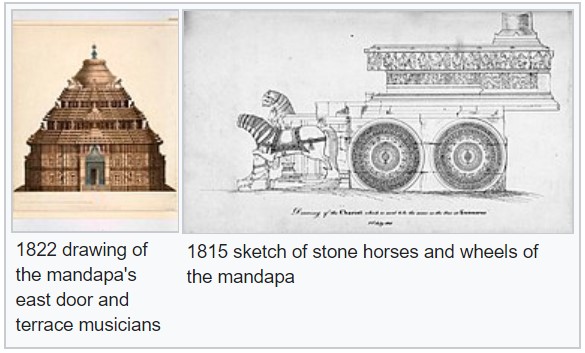
Architecture of the Konark Sun Temple
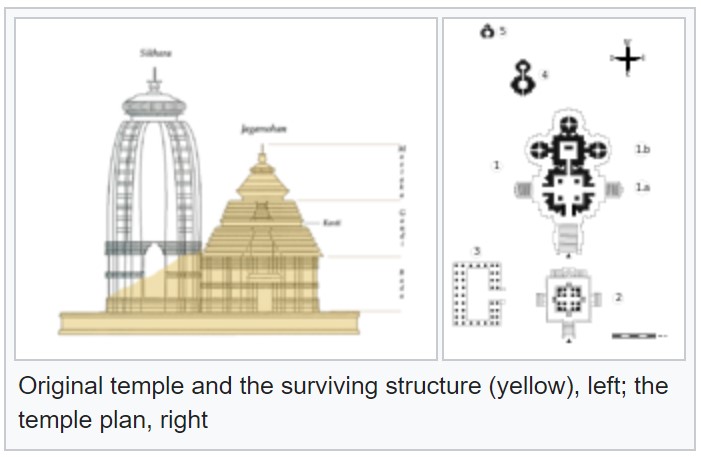
- The temple follows the traditional style of Kalinga architecture.
- It is oriented towards the east so that the first rays of the sunrise strike the main entrance.
- The temple plan includes all the traditional elements of a Hindu temple set on a square plan.
- The main temple at Konark, locally called the deul, no longer exists. It was surrounded by subsidiary shrines containing niches depicting Hindu deities, particularly Surya in many of his aspects. The original temple had a main sanctum sanctorum (vimana).
- The surviving structure has three tiers of six pidas each. These diminish incrementally and repeat the lower patterns.
- The stone temple was made from three types of stone. Chlorite, Laterite and Khondalite.
AGAPPE CHITRA MAGNA FOR DETECTION OF COVID 19
Focus: GS-III Science and Technology
Why in news?
The commercial launch of, Agappe Chitra Magna, a magnetic nanoparticle-based RNA extraction kit for use during testing for detection of COVID-19 developed by Sree Chitra Tirunal Institute for Medical Sciences and Technology (SCTIMST) – Trivandrum, an Institute of National Importance of the Department of Science and Technology (DST) along with Agappe Diagnostics Ltd, an in vitro diagnostics manufacturing company based in Cochin is being organized on May 21, 2020, at 4.30 PM.
Details and Significance
- Inexpensive, fast, and accurate testing for COVID-19 virus is the cornerstone of containing its spread and providing appropriate help to the infected.
- It uses an innovative technology for isolating RNA using magnetic nanoparticles to capture the RNA from the patient sample.
- The magnetic nanoparticle beads bind to the viral RNA and, when exposed to a magnetic field, give a highly purified and concentrated RNA.
- As the sensitivity of the detection method is dependent on getting an adequate quantity of viral RNA, this innovation enhances the chances of identifying positive cases.
INLAND WATER TRANSIT AND TRADE BETWEEN INDIA AND BANGLADESH
Focus: GS-II International Relations, GS-I Geography, Prelims
Why in news?
- The Standing Committee on the Protocol and the Shipping Secretary level Talks are the institutional arrangements between the two friendly neighbors to discuss and make the Protocol more effective.
- During the discussions between India and Bangladesh at these meetings held in October, 2018 in New Delhi and in December, 2019 in Dhaka, key decisions were taken on the extension of protocol routes, inclusion of new routes and declaration of new Ports of Call to facilitate trade between the two countries.
- The number of Indo Bangladesh Protocol (IBP) routes are being increased from 8 to 10 and new locations are also added to the existing routes.
- These decisions have been made effective with the signing of 2nd Addendum to the Protocol on 20th May 2020.
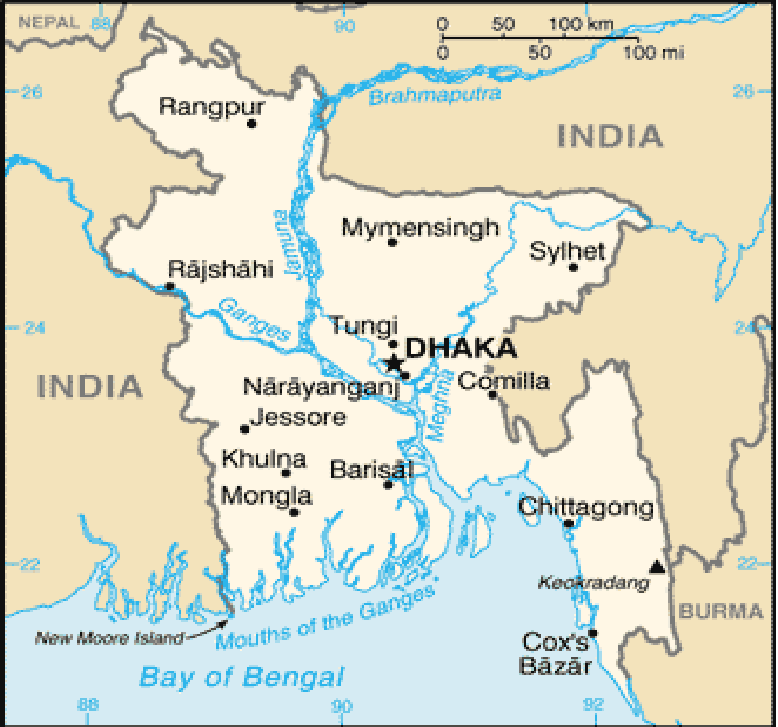
Background of India-Bangladesh Inland Water Transit
- People’s Republic of Bangladesh and the Republic of India have a long standing and time-tested Protocol on Transit and Trade through inland waterways of both countries.
- This Protocol, which was first signed in 1972 (immediately after independence of Bangladesh), is a reflection of shared history and friendship between the two countries.
- It was last renewed in 2015 for five years with a provision for its automatic renewal for a further period of five years giving long term assurance to various stakeholders.
- The existing protocol routes include Kolkata-Pandu-Kolkata, Kolkata-Karimganj – Kolkata, Rajshahi-Dhulian-Rajshahi and Pandu-Karimganj-Pandu.
- The Inland Waterways Authority of India (IWAI) which came into existence on 27th October 1986 for development and regulation of inland waterways for shipping and navigation is the competent Authority on Indian Side.
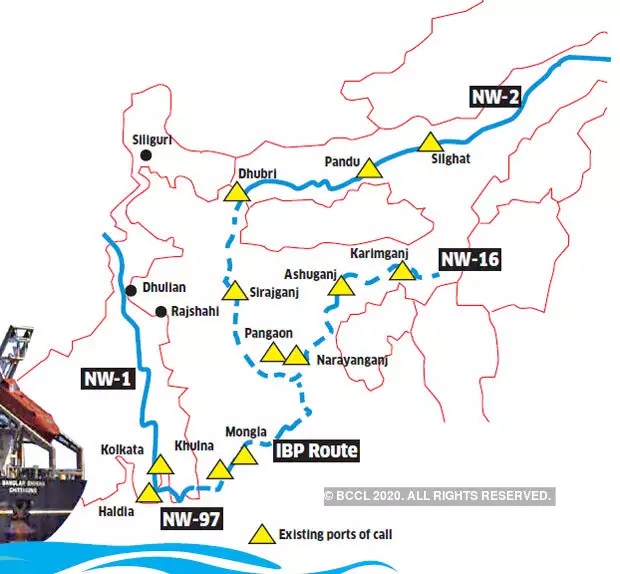
Details of Places Added and Changes made
- Inclusion of Sonamura- Daudkhandi stretch of Gumti river will improve the connectivity of Tripura and adjoining States.
- The operationalization of Rajshahi-Dhulian-Rajshahi Routes and their extension up to Aricha will help the augmentation of infrastructure in Bangladesh.
- Inclusion of Jogigopha in India and Bahadurabad in Bangladesh as new Port of Call will provide connectivity to Meghalaya, Assam and Bhutan. Jogigopha also becomes important, since, a Multimodal Logistics Park is proposed to be established there.
- As a path-breaking development, both sides have agreed to introduce trade between Chilmari (Bangladesh) and Dhubri (India) through the use of shallow draft mechanized vessels.
- Inland vessels of both the countries can ply on the designated protocol route and dock at Ports of Call in each country, notified for loading/unloading of cargo.



